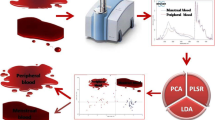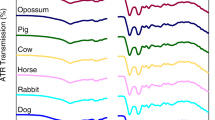Abstract
Body fluid traces can provide highly valuable clues in forensic investigations. In particular, bloodstains are a common occurrence in criminal investigation, and the discrimination of menstrual and peripheral blood is a crucial step for casework involving rape and sexual assault. Most of the current protocols require the detection of characteristic menstrual blood components using sophisticated procedures that need to be performed in a laboratory. The present study uses attenuated total reflection Fourier transform-infrared (ATR FT-IR) spectroscopy as a nondestructive technique for discriminating menstrual and peripheral blood traces. This method incorporates statistical analysis and was evaluated by internal and external validation testing. A partial least squares discriminant analysis (PLSDA) classification model was created for differentiating the two types of blood in a binary manner. Excellent separation between menstrual and peripheral blood samples was achieved during internal validation. External validation resulted in 100% accuracy for predicting a sample as peripheral or menstrual blood. This study demonstrates that ATR FT-IR spectroscopy combined with chemometrics is a reliable approach for rapid and nondestructive discrimination of menstrual and peripheral bloodstains. It offers a significant advantage to forensic science due to the availability of portable instruments and the potential for bloodstain analysis at a crime scene.

Graphical abstract





Similar content being viewed by others
References
Virkler K, Lednev IK. Analysis of body fluids for forensic purposes: from laboratory testing to non-destructive rapid confirmatory identification at a crime scene. Forensic Sci Int. 2009;188:1–17.
Eckert WG, James SH. Interpretation of bloodstain evidence at crime scenes. 2nd ed. Boca Raton, FL: CRC Press; 1998.
Archambault J, Lonsway KA, O’Donnell P. Understanding the role of DNA evidence in a sexual assault investigation: part 6. Policy responses, assessment, and recommendations for practice. End Violence Against Women International. 1/2014:1–28.
People v. Dalcollo. 669 N.E.2d: Appellate Court, Second District; 1996. p. 378.
State of Louisiana v. Lewis. Court of Appeal, Third Circuit, 04–0020.
Wickenheiser R. Former director of Acadiana Criminalistics Laboratory in New Iberia, Louisiana. Private communication, October 2020.
Payne-James J, Byard RW. Encyclopedia of forensic and legal medicine. 2nd ed. Amsterdam: Academic Press; 2016.
Farage MA, Maibach HI. The vulva: anatomy, physiology, and pathology. New York, NY: Informa Healthcare USA, Inc.; 2006.
Fraser IS, McCarron G, Markham R, Resta T. Blood and total fluid content of menstrual discharge. Obstet Gynecol. 1985;65:194–8.
Huggins GR, Preti G. Vaginal odors and secretions. Clin Obstet Gynecol. 1981;24:355–77.
Grimwade J, Fraser IS, Farrell E. Menstruation. The body of knowledge: everything you need to know about the female cycle. Port Melbourne, Victoria: William Heinemann Australia; 1995. p. 16–43.
Whitehead PH, Divall GB. Assay of “soluble fibrinogen” in bloodstain extracts as an aid to identification of menstrual blood in forensic science: preliminary findings. Clin Chem. 1973;19:762–5.
Whitehead PH, Divall GB. The identification of menstrual blood — the immunoelectrophoretic characterisation of soluble fibrinogen from menstrual bloodstain extracts. Forensic Sci. 1974;4:53–62.
Baker DJ, Grimes EA, Hopwood AJ. D-dimer assays for the identification of menstrual blood. Forensic Sci Int. 2011;212:210–4.
Holtkötter H, Rodrigues Dias Filho C, Schwender K, Stadler C, Vennemann M, Pacheco AC, et al. Forensic differentiation between peripheral and menstrual blood in cases of alleged sexual assault—validating an immunochromatographic multiplex assay for simultaneous detection of human hemoglobin and D-dimer. Int J Legal Med. 2018;132:683–90.
Hanson EK, Ballantyne J. Rapid and inexpensive body fluid identification by RNA profiling-based multiplex High Resolution Melt (HRM) analysis. F1000Res. 2014;2:281.
Jakubowska J, Maciejewska A, Bielawski KP, Pawłowski R. mRNA heptaplex protocol for distinguishing between menstrual and peripheral blood. Forensic Sci Int Genet. 2014;13:53–60.
Haas C, Hanson E, Anjos MJ, Ballantyne KN, Banemann R, Bhoelai B, et al. RNA/DNA co-analysis from human menstrual blood and vaginal secretion stains: results of a fourth and fifth collaborative EDNAP exercise. Forensic Sci Int Genet. 2014;8:203–12.
Bauer M, Patzelt D. Evaluation of mRNA markers for the identification of menstrual blood. J Forensic Sci. 2002;47:1278–82.
Gray D, Frascione N, Daniel B. Development of an immunoassay for the differentiation of menstrual blood from peripheral blood. Forensic Sci Int. 2012;220:12–8.
An JH, Choi A, Shin K-J, Yang WI, Lee HY. DNA methylation-specific multiplex assays for body fluid identification. Int J Legal Med. 2013;127:35–43.
Hanson EK, Mirza M, Rekab K, Ballantyne J. The identification of menstrual blood in forensic samples by logistic regression modeling of miRNA expression. Electrophoresis. 2014;35:3087–95.
Muro CK, Lednev IK. Identification of individual red blood cells by Raman microspectroscopy for forensic purposes: in search of a limit of detection. Anal Bioanal Chem. 2017;409:287–93.
Muro CK, Doty KC, Bueno J, Halámková L, Lednev IK. Vibrational spectroscopy: recent developments to revolutionize forensic science. Anal Chem. 2015;87:306–27.
Mistek E, Fikiet MA, Khandasammy SR, Lednev IK. Toward Locard’s exchange principle: recent developments in forensic trace evidence analysis. Anal Chem. 2019;91:637–54.
Bunaciu AA, Fleschin Ş, Hoang VD, Aboul-Enein HY. Vibrational spectroscopy in body fluids analysis. Crit Rev Anal Chem. 2017;47:67–75.
Mistek E, Lednev IK. FT-IR spectroscopy for identification of biological stains for forensic purposes. Spectroscopy. 2018;33:8–19.
Elkins KM. Rapid presumptive “fingerprinting” of body fluids and materials by ATR FT-IR spectroscopy. J Forensic Sci. 2011;56:1580–7.
Orphanou C-M, Walton-Williams L, Mountain H, Cassella J. The detection and discrimination of human body fluids using ATR FT-IR spectroscopy. Forensic Sci Int. 2015;252:e10–e6.
Takamura A, Watanabe K, Akutsu T, Ozawa T. Soft and robust identification of body fluid using Fourier transform infrared spectroscopy and chemometric strategies for forensic analysis. Sci Rep. 2018;8:8459.
Gregório I, Zapata F, García-Ruiz C. Analysis of human bodily fluids on superabsorbent pads by ATR-FTIR. Talanta. 2017;162:634–40.
Takamura A, Watanabe K, Akutsu T, Ikegaya H, Ozawa T. Spectral mining for discriminating blood origins in the presence of substrate interference via attenuated total reflection Fourier transform infrared spectroscopy: postmortem or antemortem blood? Anal Chem. 2017;89:9797–804.
Mistek E, Lednev IK. Identification of species’ blood by attenuated total reflection (ATR) Fourier transform infrared (FT-IR) spectroscopy. Anal Bioanal Chem. 2015;407:7435–42.
Mistek-Morabito E, Lednev IK. Discrimination between human and animal blood by attenuated total reflection Fourier transform-infrared spectroscopy. Commun Chem. 2020;3:178.
Mistek E, Halámková L, Lednev IK. Phenotype profiling for forensic purposes: nondestructive potentially on scene attenuated total reflection Fourier transform-infrared (ATR FT-IR) spectroscopy of bloodstains. Forensic Chem. 2019;16:100176.
Takamura A, Halamkova L, Ozawa T, Lednev IK. Phenotype profiling for forensic purposes: determining donor sex based on Fourier transform infrared spectroscopy of urine traces. Anal Chem. 2019;91:6288–95.
Quinn AA, Elkins KM. The differentiation of menstrual from venous blood and other body fluids on various substrates using ATR FT-IR spectroscopy. J Forensic Sci. 2017;62:197–204.
Sharma S, Chophi R, Singh R. Forensic discrimination of menstrual blood and peripheral blood using attenuated total reflectance (ATR)-Fourier transform infrared (FT-IR) spectroscopy and chemometrics. Int J Legal Med. 2020;134:63–77.
Sikirzhytskaya A, Sikirzhytski V, Lednev IK. Raman spectroscopy coupled with advanced statistics for differentiating menstrual and peripheral blood. J Biophotonics. 2014;7:59–67.
Muro CK, Doty KC, de Souza Fernandes L, Lednev IK. Forensic body fluid identification and differentiation by Raman spectroscopy. Forensic Chem. 2016;1:31–8.
Vyas B, Halámková L, Lednev IK. A universal test for the forensic identification of all main body fluids including urine. Forensic Chem. 2020;20:100247.
Varmuza K, Filzmoser P. Introduction to multivariate statistical analysis in chemometrics. Boca Raton, FL: CRC Press; 2009.
Staniszewska E, Malek K, Baranska M. Rapid approach to analyze biochemical variation in rat organs by ATR FTIR spectroscopy. Spectrochim Acta A. 2014;118:981–6.
Baker MJ, Trevisan J, Bassan P, Bhargava R, Butler HJ, Dorling KM, et al. Using Fourier transform IR spectroscopy to analyze biological materials. Nat Protoc. 2014;9:1771–91.
Rinnan Å, van den Berg F, Engelsen SB. Review of the most common pre-processing techniques for near-infrared spectra. TrAC Trends Anal Chem. 2009;28:1201–22.
Engel J, Gerretzen J, Szymańska E, Jansen JJ, Downey G, Blanchet L, et al. Breaking with trends in pre-processing? TrAC Trends Anal Chem. 2013;50:96–106.
Wise BM, Gallagher NB, Bro R, Shaver JM, Windig W, Koch RS. PLS_Toolbox 3.5 for use with MATLAB. Wenatchee, WA: Eigenvector Research, Inc.; 2005.
Westad F, Marini F. Validation of chemometric models – a tutorial. Anal Chim Acta. 2015;893:14–24.
Jung JY, Lee H-S, Kang D-G, Kim NS, Cha MH, Bang O-S, et al. 1H-NMR-based metabolomics study of cerebral infarction. Stroke. 2011;42:1282–8.
Morse-McNabb E, Sheffield K, Clark R, Robson S, Lewis H. Calibration and validation of state wide land cover mapping. GSR_2. 2012.
Wise BM, Martens H, Høy M, Bro R, Brockhoff PB. Calibration transfer by generalized least squares. Seventh Scandinavian Symposium on Chemometrics (SSC7), Copenhagen, Denmark. 2001.
Olsztyńska-Janus S, Szymborska-Małek K, Gąsior-Głogowska M, Walski T, Komorowska M, Witkiewicz W, et al. Spectroscopic techniques in the study of human tissues and their components. Part I: IR spectroscopy. Acta Bioeng Biomech. 2012;14:101–15.
Kanagathara N, Thirunavukkarasu M, Esther Jeyanthi C, Shenbagarajan P. FTIR and UV-visible spectral study on normal blood samples. Int J Pharm Bio Sci. 2011;1:74–81.
Chiriboga L, Xie P, Yee H, Vigorita V, Zarou D, Zakim D, et al. Infrared spectroscopy of human tissue. I. Differentiation and maturation of epithelial cells in the human cervix. Biospectroscopy. 1998;4:47–53.
Wong PT, Wong RK, Caputo TA, Godwin TA, Rigas B. Infrared spectroscopy of exfoliated human cervical cells: evidence of extensive structural changes during carcinogenesis. Proc Natl Acad Sci USA. 1991;88:10988–92.
Butler HJ, Ashton L, Bird B, Cinque G, Curtis K, Dorney J, et al. Using Raman spectroscopy to characterize biological materials. Nat Protoc. 2016;11:664–87.
McLaughlin G, Fikiet MA, Ando M, Hamaguchi H-o, Lednev IK. Universal detection of body fluid traces in situ with Raman hyperspectroscopy for forensic purposes: evaluation of a new detection algorithm (HAMAND) using semen samples. J Raman Spectrosc. 2019;50:1147–53.
Rein AJ, Seelenbinder J. Handheld and portable FTIR spectrometers for the analysis of materials: taking the lab to the sample. Am Lab. 2013.
Fujihara J, Fujita Y, Yamamoto T, Nishimoto N, Kimura-Kataoka K, Kurata S, et al. Blood identification and discrimination between human and nonhuman blood using portable Raman spectroscopy. Int J Legal Med. 2017;131:319–22.
Morillas AV, Gooch J, Frascione N. Feasibility of a handheld near infrared device for the qualitative analysis of bloodstains. Talanta. 2018;184:1–6.
Pereira JFQ, Silva CS, Vieira MJL, Pimentel MF, Braz A, Honorato RS. Evaluation and identification of blood stains with handheld NIR spectrometer. Microchem J. 2017;133:561–6.
Doty KC, McLaughlin G, Lednev IK. A Raman “spectroscopic clock” for bloodstain age determination: the first week after deposition. Anal Bioanal Chem. 2016;408:3993–4001.
Doty KC, Muro CK, Lednev IK. Predicting the time of the crime: bloodstain aging estimation for up to two years. Forensic Chem. 2017;5:1–7.
Acknowledgments
We are grateful to all volunteers who donated their blood for use in this study. I.K.L. also acknowledges the Government of the Russian Federation for supporting scientific research projects implemented under the supervision of leading scientists at Russian institutions of higher education (proposal no. №2020-220-08-2389).
Funding
This project was supported by Awards No. 2017-R2-CX-0006 and 2017-DN-BX-0135, awarded by the National Institute of Justice, Office of Justice Programs, U.S. Department of Justice.
Author information
Authors and Affiliations
Corresponding author
Ethics declarations
The authors declare no competing interests.
All procedures performed in studies involving human participants were in accordance with the ethical standards of the University at Albany’s Institutional Research Board (IRB). The study was approved by the University at Albany’s IRB (Study No. 18E091).
Disclaimer
The opinions, findings, and conclusions or recommendations expressed in this publication are those of the authors and do not necessarily reflect those of the U.S. Department of Justice.
Additional information
Publisher’s Note
Springer Nature remains neutral with regard to jurisdictional claims in published maps and institutional affiliations.
Supplementary information
ESM 1
(PDF 550 kb)
Rights and permissions
About this article
Cite this article
Mistek-Morabito, E., Lednev, I.K. Discrimination of menstrual and peripheral blood traces using attenuated total reflection Fourier transform-infrared (ATR FT-IR) spectroscopy and chemometrics for forensic purposes. Anal Bioanal Chem 413, 2513–2522 (2021). https://doi.org/10.1007/s00216-021-03206-w
Received:
Revised:
Accepted:
Published:
Issue Date:
DOI: https://doi.org/10.1007/s00216-021-03206-w




